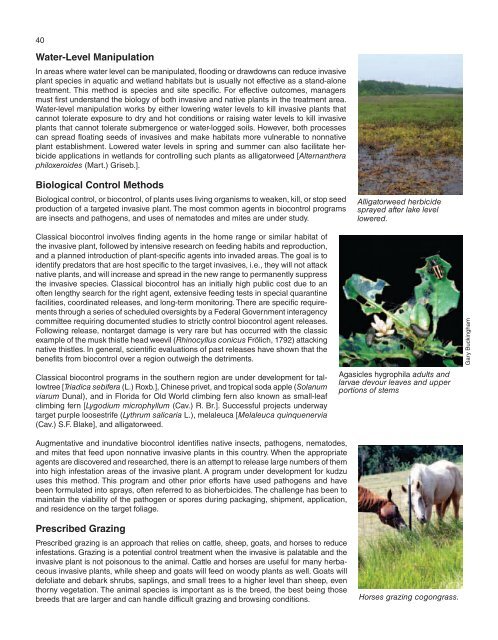A Management Guide for Invasive Plants in Southern Forests James ...
A Management Guide for Invasive Plants in Southern Forests James ...
A Management Guide for Invasive Plants in Southern Forests James ...
- No tags were found...
You also want an ePaper? Increase the reach of your titles
YUMPU automatically turns print PDFs into web optimized ePapers that Google loves.
40Water-Level ManipulationIn areas where water level can be manipulated, flood<strong>in</strong>g or drawdowns can reduce <strong>in</strong>vasiveplant species <strong>in</strong> aquatic and wetland habitats but is usually not effective as a stand-alonetreatment. This method is species and site specific. For effective outcomes, managersmust first understand the biology of both <strong>in</strong>vasive and native plants <strong>in</strong> the treatment area.Water-level manipulation works by either lower<strong>in</strong>g water levels to kill <strong>in</strong>vasive plants thatcannot tolerate exposure to dry and hot conditions or rais<strong>in</strong>g water levels to kill <strong>in</strong>vasiveplants that cannot tolerate submergence or water-logged soils. However, both processescan spread float<strong>in</strong>g seeds of <strong>in</strong>vasives and make habitats more vulnerable to nonnativeplant establishment. Lowered water levels <strong>in</strong> spr<strong>in</strong>g and summer can also facilitate herbicideapplications <strong>in</strong> wetlands <strong>for</strong> controll<strong>in</strong>g such plants as alligatorweed [Alternantheraphiloxeroides (Mart.) Griseb.].Biological Control MethodsBiological control, or biocontrol, of plants uses liv<strong>in</strong>g organisms to weaken, kill, or stop seedproduction of a targeted <strong>in</strong>vasive plant. The most common agents <strong>in</strong> biocontrol programsare <strong>in</strong>sects and pathogens, and uses of nematodes and mites are under study.Alligatorweed herbicidesprayed after lake levellowered.Classical biocontrol <strong>in</strong>volves f<strong>in</strong>d<strong>in</strong>g agents <strong>in</strong> the home range or similar habitat ofthe <strong>in</strong>vasive plant, followed by <strong>in</strong>tensive research on feed<strong>in</strong>g habits and reproduction,and a planned <strong>in</strong>troduction of plant-specific agents <strong>in</strong>to <strong>in</strong>vaded areas. The goal is toidentify predators that are host specific to the target <strong>in</strong>vasives, i.e., they will not attacknative plants, and will <strong>in</strong>crease and spread <strong>in</strong> the new range to permanently suppressthe <strong>in</strong>vasive species. Classical biocontrol has an <strong>in</strong>itially high public cost due to anoften lengthy search <strong>for</strong> the right agent, extensive feed<strong>in</strong>g tests <strong>in</strong> special quarant<strong>in</strong>efacilities, coord<strong>in</strong>ated releases, and long-term monitor<strong>in</strong>g. There are specific requirementsthrough a series of scheduled oversights by a Federal Government <strong>in</strong>teragencycommittee requir<strong>in</strong>g documented studies to strictly control biocontrol agent releases.Follow<strong>in</strong>g release, nontarget damage is very rare but has occurred with the classicexample of the musk thistle head weevil (Rh<strong>in</strong>ocyllus conicus Frölich, 1792) attack<strong>in</strong>gnative thistles. In general, scientific evaluations of past releases have shown that thebenefits from biocontrol over a region outweigh the detriments.Gary Buck<strong>in</strong>ghamClassical biocontrol programs <strong>in</strong> the southern region are under development <strong>for</strong> tallowtree[Triadica sebifera (L.) Roxb.], Ch<strong>in</strong>ese privet, and tropical soda apple (Solanumviarum Dunal), and <strong>in</strong> Florida <strong>for</strong> Old World climb<strong>in</strong>g fern also known as small-leafclimb<strong>in</strong>g fern [Lygodium microphyllum (Cav.) R. Br.]. Successful projects underwaytarget purple loosestrife (Lythrum salicaria L.), melaleuca [Melaleuca qu<strong>in</strong>quenervia(Cav.) S.F. Blake], and alligatorweed.Agasicles hygrophila adults andlarvae devour leaves and upperportions of stemsAugmentative and <strong>in</strong>undative biocontrol identifies native <strong>in</strong>sects, pathogens, nematodes,and mites that feed upon nonnative <strong>in</strong>vasive plants <strong>in</strong> this country. When the appropriateagents are discovered and researched, there is an attempt to release large numbers of them<strong>in</strong>to high <strong>in</strong>festation areas of the <strong>in</strong>vasive plant. A program under development <strong>for</strong> kudzuuses this method. This program and other prior ef<strong>for</strong>ts have used pathogens and havebeen <strong>for</strong>mulated <strong>in</strong>to sprays, often referred to as bioherbicides. The challenge has been toma<strong>in</strong>ta<strong>in</strong> the viability of the pathogen or spores dur<strong>in</strong>g packag<strong>in</strong>g, shipment, application,and residence on the target foliage.Prescribed Graz<strong>in</strong>gPrescribed graz<strong>in</strong>g is an approach that relies on cattle, sheep, goats, and horses to reduce<strong>in</strong>festations. Graz<strong>in</strong>g is a potential control treatment when the <strong>in</strong>vasive is palatable and the<strong>in</strong>vasive plant is not poisonous to the animal. Cattle and horses are useful <strong>for</strong> many herbaceous<strong>in</strong>vasive plants, while sheep and goats will feed on woody plants as well. Goats willdefoliate and debark shrubs, sapl<strong>in</strong>gs, and small trees to a higher level than sheep, eventhorny vegetation. The animal species is important as is the breed, the best be<strong>in</strong>g thosebreeds that are larger and can handle difficult graz<strong>in</strong>g and brows<strong>in</strong>g conditions.Horses graz<strong>in</strong>g cogongrass.
















